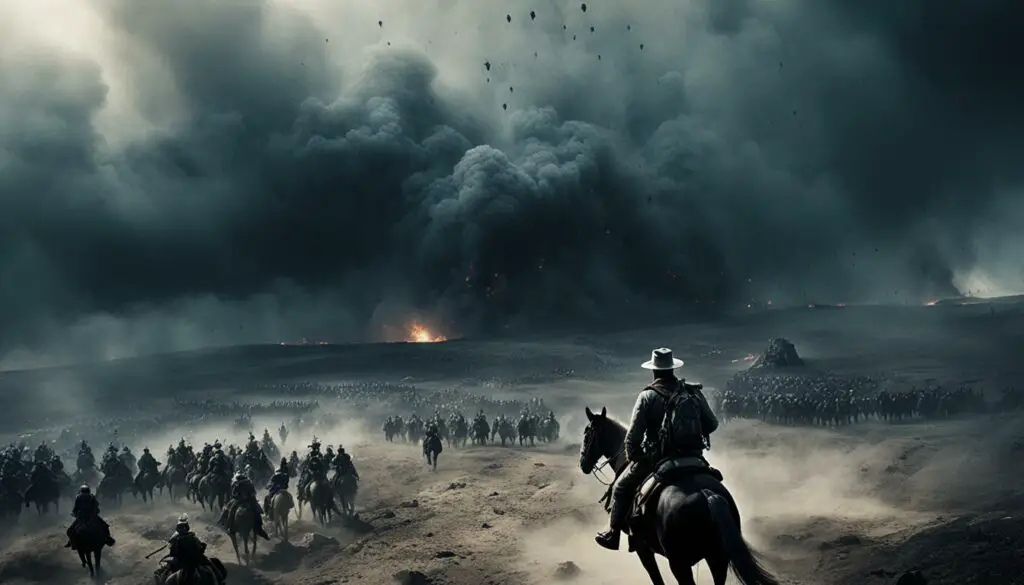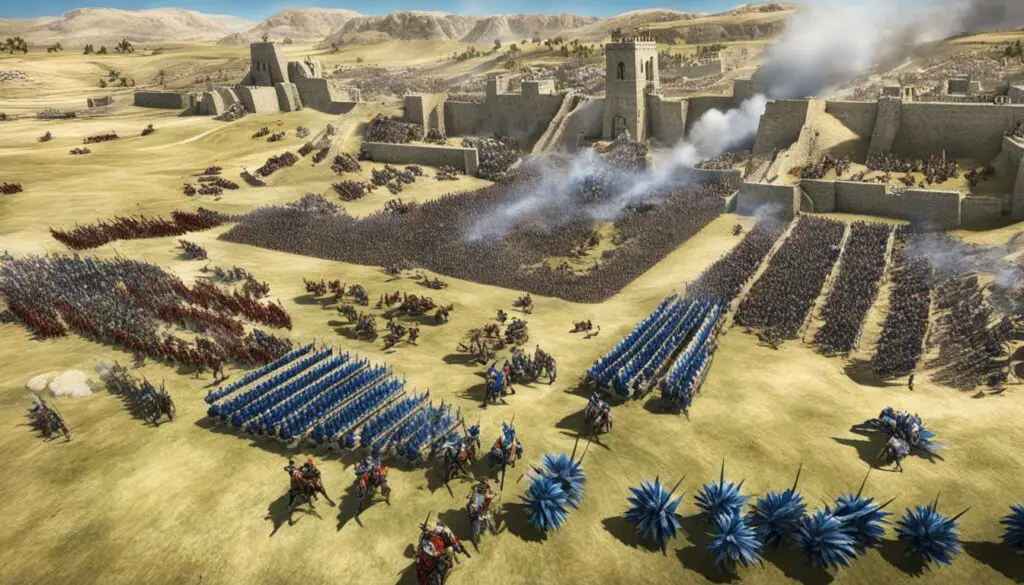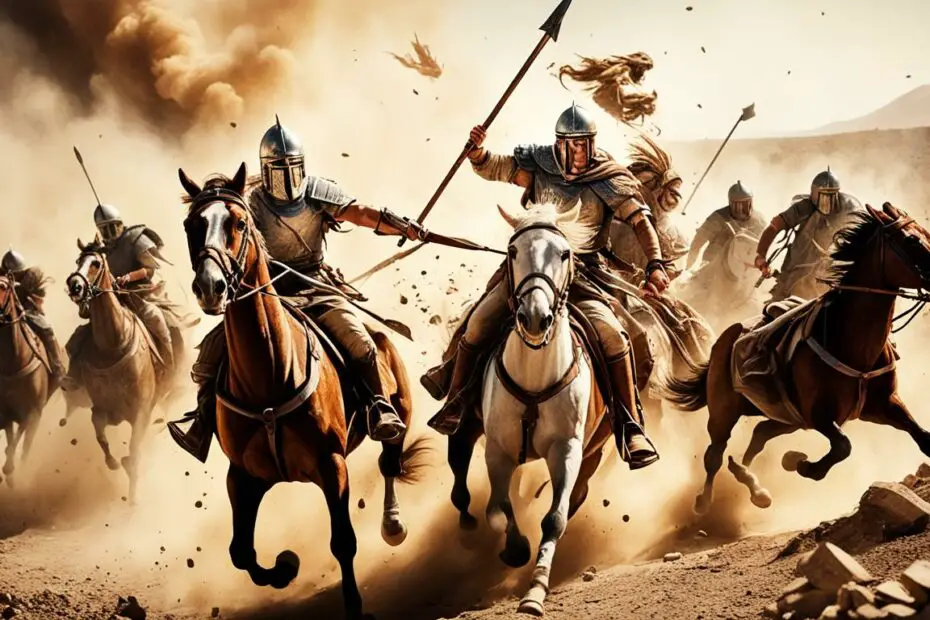The Battle of Megiddo holds a prominent place in ancient military history and biblical lore. This seminal conflict, also known as the Battle of Armageddon, took place near the ancient city of Megiddo and has had lasting significance throughout time. As we delve into the depths of this historic event, we will explore the dynamics of ancient warfare, marvel at the strategies employed, and uncover the pivotal role this battle played in shaping ancient civilizations.
Ancient battles have always captivated the imagination of military historians and enthusiasts alike. The Battle of Megiddo stands out as one of the most famous and consequential battles in human history. Its impact reverberated far beyond the ancient city walls, shaping the geopolitical landscape and giving birth to the legendary tales that have endured for centuries.
From the military tactics employed by the Allied forces to the challenges faced by commanding officers, we will immerse ourselves in the details of this legendary clash. We will also explore the historical context surrounding the Battle of Megiddo, such as the Battle of Kadesh and the ancient empires that vied for control of the region. Join us on this journey through time as we uncover the secrets of this remarkable battle, and delve into the echoes that still resonate at its historical sites to this day.
The Importance of the Suez Canal in World War I
The Battle of Megiddo, which took place in Palestine during World War I, was part of the larger Palestine Campaign. The leaders of the British Empire recognized the strategic significance of the Suez Canal in maintaining access to their eastern colonies. In order to protect their interests in the region and break the stalemate on the Western Front, the British decided to invade Palestine in 1917. General Sir Edmund Allenby, the commander of the Allied forces, played a crucial role in planning and executing the campaign.
The campaign aimed to secure the region and ensure the safety of the Suez Canal, a vital waterway that connected the Mediterranean Sea to the Indian Ocean. Controlling the Suez Canal was crucial for maintaining communication and the smooth flow of resources between the British colonies in Asia and Africa. Additionally, the canal served as a crucial supply route for the British forces stationed in Egypt and the Middle East.
The Suez Canal provided a convenient and efficient passage for the British to move troops, supplies, and equipment to and from their colonies, bypassing the long and treacherous journey around the African continent. The British recognized that losing control of the canal would severely hinder their ability to sustain their military operations in the region.
The importance of the Suez Canal in World War I cannot be overstated. Its strategic location made it a valuable asset for the British Empire in protecting their territories and maintaining control over key supply routes. The successful capture of Jerusalem by General Allenby in 1917 marked a significant turning point in the conflict and signaled the end of four centuries of Ottoman rule in the region.
The Challenges Faced by General Allenby
General Sir Edmund Allenby encountered formidable obstacles during the campaign in Palestine, requiring him to employ strategic prowess and quick-thinking to overcome these challenges. Several factors tested Allenby’s leadership skills, including the harsh and unpredictable terrain of the region, including vast deserts and treacherous landscapes. Moreover, the Ottoman Empire, supported by German forces, presented a sturdy defense and outnumbered Allenby’s forces. However, through his exceptional leadership and strategic planning, General Allenby successfully navigated these hurdles and led his troops to victory.
To ensure effective communication with his troops, General Allenby made the critical decision to move his headquarters closer to the front lines. This proximity enabled him to establish direct communication channels, facilitating swift decision-making and coordination. By maintaining direct contact with his troops, Allenby gained crucial insights and could adapt his strategies in real-time.
Additionally, General Allenby capitalized on the mobility and flexibility offered by the Desert Mounted Corps, under the leadership of Lieutenant General Sir Harry Chauvel. The Desert Mounted Corps proved instrumental in navigating the challenging terrain, exploiting gaps in the Ottoman defenses, and launching effective offensives. With their agility and ability to strike at critical junctures, the Desert Mounted Corps played a pivotal role in Allenby’s overall strategies and tactics.
By effectively addressing the challenges posed by the Ottoman Empire and leveraging the strengths of his troops and subordinates, General Allenby exemplified exceptional leadership throughout the campaign in Palestine. His ability to adapt, communicate, and utilize his resources effectively contributed to the ultimate success of the Allied forces at the Battle of Megiddo.

| Challenges Faced by General Allenby | Solutions Employed |
|---|---|
| Difficult terrain including deserts and rugged landscapes | Moved headquarters closer to the front lines to enhance communication and decision-making |
| Strong defenses and numerical advantage of the Ottoman Empire | Depended on the mobility and flexibility of the Desert Mounted Corps for strategic offensives |
| Unpredictable weather conditions in the region | Utilized meteorological intelligence to plan operations effectively |
| Limited resources and supplies | Implemented efficient logistical systems to ensure a steady flow of resources |
| Coordination among diverse Allied forces | Established effective communication channels and promoted collaboration between different national contingents |
The Clash of Empires at Megiddo
The Battle of Megiddo was a monumental clash between two mighty empires – the Ottoman Empire and the British Empire’s Egyptian Expeditionary Force (EEF). General Allenby, leading the EEF, commanded troops from various Allied nations such as Britain, Australia, New Zealand, and India. On the other side, the Ottoman forces, under the leadership of German General Liman von Sanders, held a defensive advantage with their fortified positions.
However, the EEF would prove to be an unstoppable force. With superior artillery, air power, and cavalry, they launched a relentless assault on the Ottomans, overpowering their defenses and routing their troops. The battle unfolded in two main engagements – at Sharon and Nablus – as the EEF strategically advanced further into Ottoman territory.

The Battle of Megiddo resulted in a decisive victory for the EEF and the Allied forces. Their success in breaking through the Ottoman defenses marked a significant turning point in the struggle for control of the Middle East during World War I.
Key Segments of the Battle
| Engagement | Date | Allied Forces | Ottoman Forces |
|---|---|---|---|
| Sharon | 19-20 September 1918 | Troops from Britain, Australia, New Zealand, and India | Ottoman Infantry Divisions |
| Nablus | 21-25 September 1918 | Troops from Britain, Australia, New Zealand, and India | Ottoman Infantry and Cavalry Divisions |
The Allied victory at the Battle of Megiddo had far-reaching consequences. It led to the collapse of the Ottoman Empire’s defenses in Palestine and paved the way for Allied forces to advance further into the region, effectively dismantling Ottoman control. This defeat significantly weakened the Ottoman Empire and ultimately contributed to its eventual disintegration.
Pharaoh Thutmose III and the Battle of Megiddo
The Battle of Megiddo holds historical significance beyond its World War I context. The name “Megiddo” is derived from the ancient Hebrew word for “Armageddon” and is associated with biblical lore. In ancient times, the Battle of Megiddo took place in 1457 BCE and involved Pharaoh Thutmose III of ancient Egypt. At that time, Egypt had established buffer provinces in the region to protect its interests. The battle was a response to a Canaanite revolt against Egyptian influence, backed by the Kingdom of Mitanni. Pharaoh Thutmose III successfully defeated the Canaanite coalition, maintaining Egyptian power in the region.
Pharaoh Thutmose III: A Powerful Ruler
Pharaoh Thutmose III, also known as the “Napoleon of Egypt”, was one of ancient Egypt’s most accomplished pharaohs. He ascended to the throne at a young age and embarked on numerous military campaigns, expanding Egypt’s borders and influence. The Battle of Megiddo was one of his notable victories, showcasing his strategic prowess and military acumen.
Thutmose III’s army consisted of highly trained soldiers and advanced weaponry, such as chariots and composite bows. The pharaoh’s leadership and tactical innovations enabled him to effectively coordinate large-scale battles and secure decisive victories. His success at the Battle of Megiddo reinforced Egypt’s dominant position in the region and established Thutmose III as a formidable ruler.
Impact on Ancient Egypt and the Canaanite Revolt
The Canaanite revolt against Egyptian influence posed a significant threat to the stability of ancient Egypt’s buffer provinces. Pharaoh Thutmose III’s victory at the Battle of Megiddo not only quelled the rebellion but also reaffirmed Egypt’s control over the region.
The defeat of the Canaanite coalition sent a strong message to other potential adversaries, emphasizing Egypt’s military might and determination to protect its interests. This victory further solidified Egypt’s dominance in the Levant and ensured the continued prosperity and security of its buffer provinces.
Legacy and Historical Significance
The Battle of Megiddo, both in ancient times and during World War I, holds a prominent place in military history. Its association with biblical prophecies and the term “Armageddon” has added to its mystique and cultural significance.
In ancient Egypt, the battle solidified Pharaoh Thutmose III’s legacy as one of Egypt’s greatest conquerors. His reign marked a period of unprecedented expansion and flourishing culture, leaving a lasting impact on the Egyptian civilization.
In the modern context, the Battle of Megiddo during World War I is remembered as a decisive conflict that paved the way for the collapse of the Ottoman Empire in the Middle East. General Allenby’s victory at Megiddo demonstrated the effectiveness of strategic planning, coordination, and military prowess in achieving victory on the battlefield.
General Allenby’s Path to Victory
General Allenby’s successful campaign at the Battle of Megiddo was a testament to his strategic genius and ability to adapt to the challenges he faced. In the early stages of the Palestine campaign, Allenby encountered difficulties in achieving a comprehensive victory over the Ottoman forces. However, he quickly learned from these experiences and made crucial adaptations to his tactics.
One of the key factors in Allenby’s success was his implementation of mission command. By empowering his subordinate commanders with the authority to make decisions and execute their assigned tasks, Allenby ensured a high level of coordination and flexibility in his forces. This decentralized approach to command allowed for swift and decisive actions on the battlefield.
In addition to mission command, Allenby recognized the importance of combined arms operations. He integrated infantry, artillery, cavalry, and air power seamlessly, leveraging their respective strengths to gain an advantage over the Ottomans. This comprehensive approach enabled Allenby’s forces to outmaneuver and overpower the enemy, leading to a complete victory at the Battle of Megiddo.
Furthermore, Allenby emphasized meticulous preparation and effective communication throughout his campaign. He understood the significance of thorough planning and ensured that his forces were well-equipped and well-trained for the challenges ahead. Additionally, Allenby maintained clear lines of communication with his subordinate commanders, enabling them to execute their orders efficiently and harmoniously.
FAQ
Q: What was the Battle of Megiddo?
A: The Battle of Megiddo was a decisive conflict between the Ottoman Empire and the Allied forces during World War I. It took place in Palestine and marked the climax of the struggle in the region.
Q: When did the Battle of Megiddo occur?
A: The Battle of Megiddo occurred in September 1918.
Q: Where did the Battle of Megiddo take place?
A: The battle took place near the ancient city of Megiddo in Palestine.
Q: What were the Allied forces backed by during the battle?
A: The Allied forces were backed by artillery, air power, and cavalry.
Q: Who was the commander of the Allied forces during the Battle of Megiddo?
A: The commander of the Allied forces was General Sir Edmund Allenby.
Q: What role did the Battle of Megiddo play in the final withdrawal of the Ottoman Empire from the Middle East?
A: The Battle of Megiddo played a significant role in the final withdrawal of the Ottoman Empire from the Middle East.
Q: What was the purpose of the Palestine Campaign in World War I?
A: The purpose of the Palestine Campaign was to break the stalemate on the Western Front and protect British interests in the region.
Q: Who was General Sir Edmund Allenby?
A: General Sir Edmund Allenby was the commander of the Allied forces during the Palestine Campaign in World War I.
Q: What challenges did General Allenby face during the campaign in Palestine?
A: General Allenby faced challenges such as difficult terrain, a strong defense by the Ottoman Empire, and a numerical disadvantage.
Q: Who led the Ottoman forces during the Battle of Megiddo?
A: The Ottoman forces during the Battle of Megiddo were led by German General Liman von Sanders.
Q: What nations comprised the Egyptian Expeditionary Force (EEF) under General Allenby?
A: The Egyptian Expeditionary Force (EEF) under General Allenby comprised troops from Britain, Australia, New Zealand, and India.
Q: How did General Allenby overcome the Ottoman troops during the Battle of Megiddo?
A: General Allenby’s superior artillery, air power, and cavalry ultimately overwhelmed the Ottoman troops during the battle.
Q: What is the historical significance of the Battle of Megiddo?
A: The Battle of Megiddo holds historical significance beyond its World War I context and is associated with biblical lore.
Q: Who was Pharaoh Thutmose III in relation to the Battle of Megiddo?
A: Pharaoh Thutmose III was an ancient Egyptian pharaoh who participated in the Battle of Megiddo in 1457 BCE.
Q: What factors contributed to General Allenby’s path to victory at the Battle of Megiddo?
A: General Allenby’s path to victory at the Battle of Megiddo was marked by strategic adaptations, the application of mission command, and effective utilization of resources.
